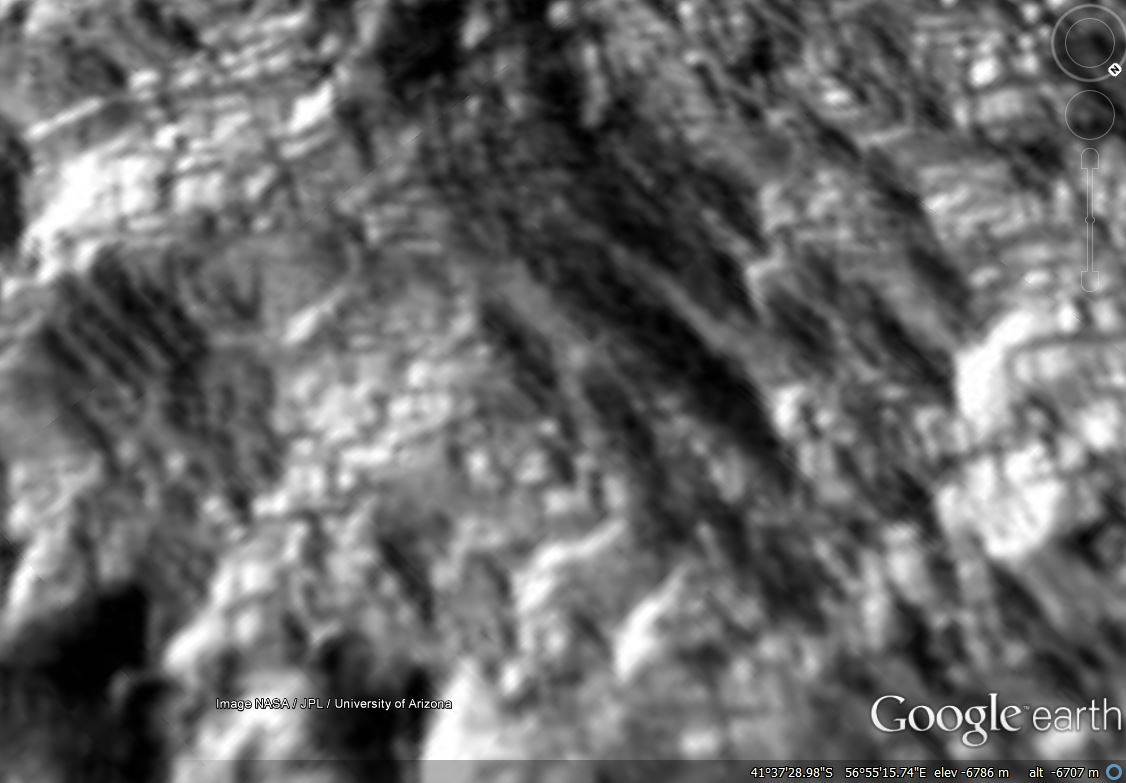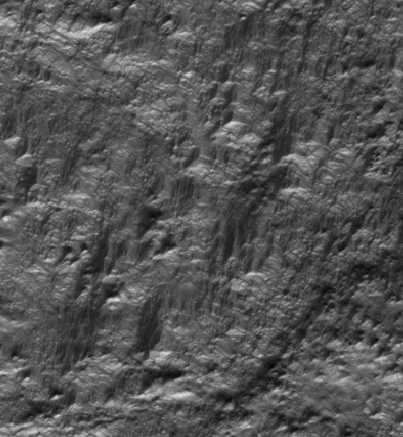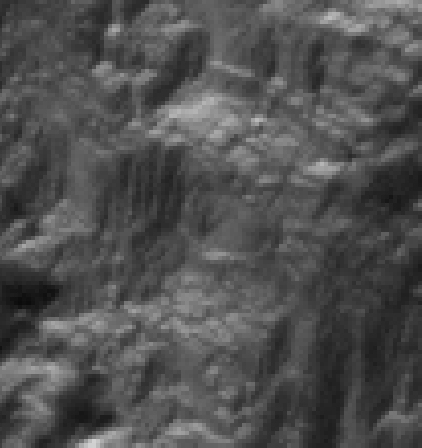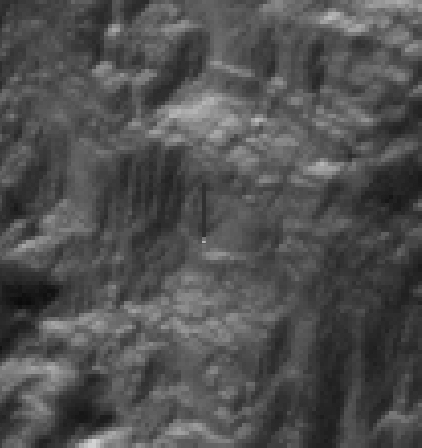It looks like you're using an Ad Blocker.
Please white-list or disable AboveTopSecret.com in your ad-blocking tool.
Thank you.
Some features of ATS will be disabled while you continue to use an ad-blocker.
share:
a reply to: wildespace
Wrong. The point of view is important, due to the very poor resolution of the images.
You must know that Hellas Basin is not an abyss, it's FLAT, a huge plain.
The exact point to watch at Hellas Basin is South-East.
But given the fact that the image was taken looking almost straight-down, rotation is irrelevant. Rotating it one way only gives an illusion of an oblique view.
Wrong. The point of view is important, due to the very poor resolution of the images.
You must know that Hellas Basin is not an abyss, it's FLAT, a huge plain.
The exact point to watch at Hellas Basin is South-East.
edit on 16-5-2014 by Arken because: (no reason given)
a reply to: Arken
I don't understand. If you're looking straight down on a flat plain, what does it matter which way you rotate the image? (apart from the convention that North should be up)
And what does resolution have to do with anything? But 50cm/pixel ground resolution is very good for an orbiting spacecraft. MRO can see the car-sized Curiosity rover, surely it would easily see cities and building complexes?
I don't understand. If you're looking straight down on a flat plain, what does it matter which way you rotate the image? (apart from the convention that North should be up)
And what does resolution have to do with anything? But 50cm/pixel ground resolution is very good for an orbiting spacecraft. MRO can see the car-sized Curiosity rover, surely it would easily see cities and building complexes?
a reply to: wildespace
The problem with what you have written here is that you assume that all beings are going to be roughly the same size as we are and that their structures will be in the same size-range as ours.
On a different planet and for a totally different species you cannot assume that. Surely you have to understand that?
The problem with what you have written here is that you assume that all beings are going to be roughly the same size as we are and that their structures will be in the same size-range as ours.
On a different planet and for a totally different species you cannot assume that. Surely you have to understand that?
edit on 16 May 2014 by
qmantoo because: typo
Your shadow is in the wrong place then.
In your OP images, you point to where the "obelisk" is, and you indicate the shadow it is casting.....
Except that can not be as the "shadow" is going the wrong way.
The sun is shining from the northwest in the image. You can clearly see the shadows of everything running towards the southeast.
Your "shadow" is running to the northeast. That would put the sun in the southwest....and if you zoom out, you can clearly see by looking at the surface features that is not the case at all.
The sun is to the northwest.
This is looking at your "obelisk" with the image orientated correctly (the top of the image is towards the north), where as your OP images are flipped around.
So it's not a shadow of an object sticking up out of the ground.
The image is 1.4 degrees from top down....meaning that it is not an oblique view either, so even if it was an obelisk, an obelisk viewed from 1.4 degrees from top down is not going to show you hardly any of it's sides.
For example, take a look at this image of the Washington monument. It's an image that is several degrees from top down, so we can actually see one of the sides of the monument, and the shadow of it is in the same direction as other shadows in the image:
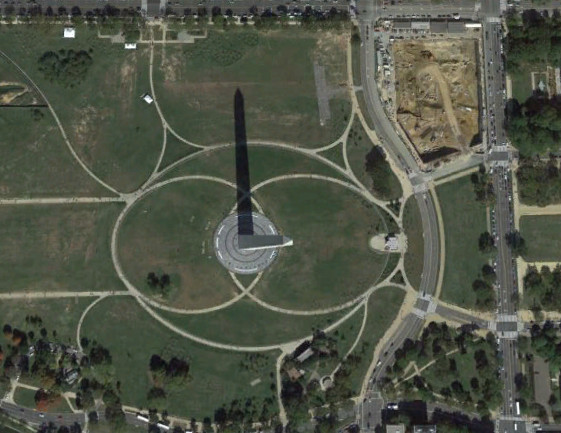
Where as when you get under 2 degrees of top down, you're not going to see too much side of any object, but only it's top.
In my opinion, the "obelisk" shadow, is area that is a depression of the ground there, not getting as much sunlight as the other areas.
In your OP images, you point to where the "obelisk" is, and you indicate the shadow it is casting.....
Except that can not be as the "shadow" is going the wrong way.
The sun is shining from the northwest in the image. You can clearly see the shadows of everything running towards the southeast.
Your "shadow" is running to the northeast. That would put the sun in the southwest....and if you zoom out, you can clearly see by looking at the surface features that is not the case at all.
The sun is to the northwest.
This is looking at your "obelisk" with the image orientated correctly (the top of the image is towards the north), where as your OP images are flipped around.
So it's not a shadow of an object sticking up out of the ground.
The image is 1.4 degrees from top down....meaning that it is not an oblique view either, so even if it was an obelisk, an obelisk viewed from 1.4 degrees from top down is not going to show you hardly any of it's sides.
For example, take a look at this image of the Washington monument. It's an image that is several degrees from top down, so we can actually see one of the sides of the monument, and the shadow of it is in the same direction as other shadows in the image:

Where as when you get under 2 degrees of top down, you're not going to see too much side of any object, but only it's top.
In my opinion, the "obelisk" shadow, is area that is a depression of the ground there, not getting as much sunlight as the other areas.
originally posted by: eriktheawful
In my opinion, the "obelisk" shadow, is area that is a depression of the ground there, not getting as much sunlight as the other areas.
Exactly what I thought on my first observation.
originally posted by: wildespace
originally posted by: Arken
a reply to: ArMaP
My bad. Sorry.
Here the coordinates of the "Obelisk", (rotation on South-East, as all this area must be seen).
Thanks for the coordinates, we can finally find it for ourselves. But given the fact that the image was taken looking almost straight-down, rotation is irrelevant. Rotating it one way only gives an illusion of an oblique view. There's no obelisk.
Thus, according to this idiot. [...] And so this idiot NASA / JPL / UoA
Why so rude, Arken?
I knew you as a boy friendly and polite, but I see that I was wrong...
But seriously, care to elaborate why you find the statement about wind erosion ridiculous? Are you a planetologist or geologist yourself?
P.S. just found that "obelisk" in HiView.
At 1:1 scale:
Magnified x4 using pixel resize:
So, a few things to recap:
1. the image is top-down, there's no oblique view.
2. the Sun was very low above the horizon, so a shadow from any tall object would have been very long. The low Sun angle also accentuates shadows seen here - meaning that what we're really looking at is small and shallow dune-like terrain features. No oblique views of square houses or anything like that.
3. another thing I realised - the sun-facing side of the obelisk would have been much brighter, at least as bright as the sunlit surfaces of these "square" formations.
P.P.S. Here's what an upright obelisk would look like, if it really stood there:
Bright sunlit side, long shadow. Note that the base of the "obelisk" is only about 1 to 2 pixels wide, translating to about 50 cm to 1 meter.
Can't you see, the obelisk is the thumb.
originally posted by: wildespace
P.S. just found that "obelisk" in HiView.
From my point of view, it looks like the "shadow" is a wind-blown dust feature. I agree that looking at these things for very long makes your eyes cross.
a reply to: Arken
I sent an email to Candy Hansen and she was very polite and wanted to look at the thread where we were discussing the photo for which she wrote those comments, and after I sent her this thread's address she answered that her comments "only had to do with a tiny tiny fraction of Hellas".
I sent an email to Candy Hansen and she was very polite and wanted to look at the thread where we were discussing the photo for which she wrote those comments, and after I sent her this thread's address she answered that her comments "only had to do with a tiny tiny fraction of Hellas".
a reply to: Arken
Why did you say this?
Then why did you compare it to an image of structures on a steep slope?
You must know that Hellas Basin is not an abyss, it's FLAT, a huge plain.
Why did you say this?
How can there be "heights" on a flat plain?
This anomaly that stands out from the perfectly squared heights of Hellas Basin could be one of the most important Martian anomalies that I have discovered till now.
edit on 5/19/2014 by Phage because: (no reason given)
The small dark lines mistaken here for obelisk and its shadow may be simply dark sand dunes.
It must be noted that the Google image is about as detailed as it gets; it uses the original HiRISE image, and the features we're looking at are realively small (a few meters to a few dozens of meters)
It must be noted that the Google image is about as detailed as it gets; it uses the original HiRISE image, and the features we're looking at are realively small (a few meters to a few dozens of meters)
edit on 19-5-2014 by wildespace because: (no reason given)
new topics
-
The mysterious death of Aileen Conway
General Chit Chat: 1 hours ago -
Half-Life 2 is 20 Years Old - its Also Free on Steam until the 18th
Video Games: 5 hours ago -
Does the Trump win mean No More Taylor Swift??
Politicians & People: 9 hours ago -
Trump-appointed judge blocks Biden administration overtime rule
Social Issues and Civil Unrest: 11 hours ago
top topics
-
Don't cry do Cryo instead
General Chit Chat: 16 hours ago, 12 flags -
Does the Trump win mean No More Taylor Swift??
Politicians & People: 9 hours ago, 12 flags -
Trump-appointed judge blocks Biden administration overtime rule
Social Issues and Civil Unrest: 11 hours ago, 8 flags -
The mysterious death of Aileen Conway
General Chit Chat: 1 hours ago, 5 flags -
Half-Life 2 is 20 Years Old - its Also Free on Steam until the 18th
Video Games: 5 hours ago, 1 flags
active topics
-
President-elect TRUMP Picks MATT GAETZ for his ATTORNEY GENERAL - High Level PANIC Ensues.
2024 Elections • 81 • : EyeoftheHurricane -
WATCH LIVE: US Congress hearing on UFOs, unidentified anomalous phenomena
Aliens and UFOs • 99 • : DaydreamerX -
The mysterious death of Aileen Conway
General Chit Chat • 1 • : DAVID64 -
President-Elect DONALD TRUMP's 2nd-Term Administration Takes Shape.
Political Ideology • 209 • : EyeoftheHurricane -
Tariffs all around, Except for ...
Dreams & Predictions • 29 • : KnowItAllKnowNothin -
Does the Trump win mean No More Taylor Swift??
Politicians & People • 45 • : Oldcarpy2 -
Mike Tyson returns 11-15-24
World Sports • 67 • : argentus -
The art of being offended
Social Issues and Civil Unrest • 52 • : argentus -
Mood Music Part VI
Music • 3703 • : underpass61 -
Old School Punk
Music • 560 • : underpass61

